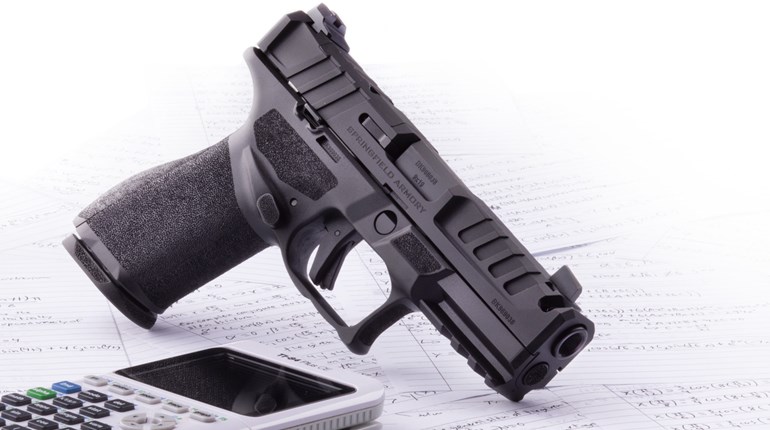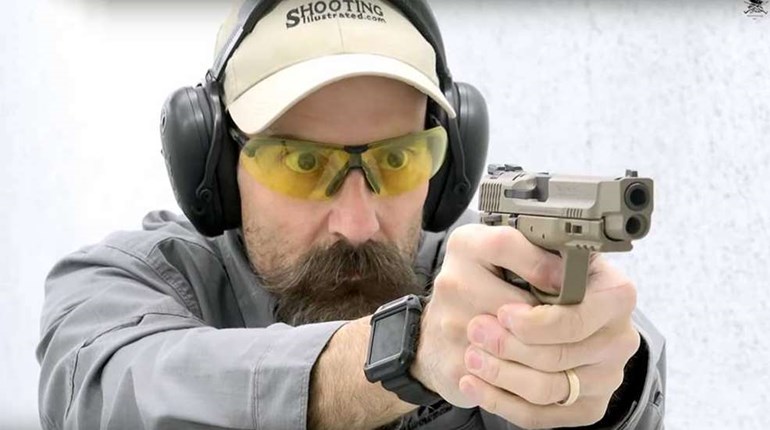
The battle rages on between point shooters and those who rely on sighted fire. Is there a true winner in that contest? What are the pros and cons of each and which parts of each, if any, are utilized by professional lead slingers who carry a gun for food?
Spanning from the late 1500s through the early 1800s, pistols were predominantly manufactured without sights. Even by the turn of the 19th Century you might have seen a front sight on a pistol such as the Colt Model 1873. However, it was later that both front and rear sight became the manufacturing standard. In essence, it can be said that at inception, there was only point shooting and that it lasted for the better part of 300 years.
Some would argue that even after the advent of sights and throughout the 1800s, using of “horse pistols” and “hip shooting,” one could extend that timeline through both world wars where point shooting can be found in U.S. Army training manuals (circa early 1900s), on up to the early 1970s when the FBI was still teaching hip shooting.
The term "point shooting" infers that, like taking your index finger and pointing it at an object across the room, you simply grasp the pistol and using only your body—not your eyes—aim and keep the gun oriented to the target throughout the firing process. You may have heard of other equivalent terms to point shooting such as “intuitive” or “instinctive” shooting which relate to this concept of pointing your index finger.
An argument that rages on to this day throughout both the defensive and competitive shooting communities is the comparison of point shooting (firing without using sights) versus shooting with the usage of sights.
The defensive shooting community claims its point-shooting roots from the days of lawmen like Wyatt Earp through the FBI’s legendary sharpshooter Jelly Bryce and distinguished sharpshooters such as British Royal Marine (and police officer) William Ewart Fairbairn, American military (and OSS) officer Rex Applegate, British soldier and firearms expert Eric Anthony Sykes, American lawman William “Bill” Henry Jordan (USMC), and others. One also cannot argue the efficacy of point shooting without mentioning the likes of 18-time world record holder Robert “Bob” Munden, Jr., who was well known in the shooting sport of Fast Draw as an ardent point shooter.
The two sides of the argument are based on the result of shooting performance—that is the measurement of accuracy and speed. The point shooting side of the argument claims that drawing the gun and using only your body for alignment reduces the number of steps needed to orient the pistol with your intended target and therefore reduces the amount of time required to break the shot.
The sighted fire side of the argument claims that without sighted fire for more technical shots—such as when greater distances come into play, reduced target area like hostage rescue (defensive shooting), moving targets or when the penalty for missing is very high—that the odds on missing with point shooting alone are arguably increased.
Rather than spend valuable time arguing one side or the other, I'll ask a different question: How can we take the best that both sides have to offer and use it to become a better shooter?
Regardless of which side of the argument you may stand upon, presenting the handgun (drawing) is performed with your strong hand only. Up to and including the moment just before bringing the sights up to your line of sight, you are essentially pointing the gun in the direction of the target, or point shooting. It’s only if you add the steps of bringing the sights up to your line of sight and utilize them to refine your target alignment are you verifying your alignment with the sights or using sighted fire.
One of the arguments in favor of point shooting is that point shooting is faster. Standing at arms’ length or at 3, 5 or 7 yards, depending upon the shooter’s skill level, even 10 yards from the target, ripping it out of the holster with strong hand only and aligning the muzzle with the target is always faster than the added mechanical steps of bringing both hands together and making a secondary alignment. You can run this on a shot timer and compare the difference.
The advantages of point shooting are speed and accuracy up close at or under 7 yards (21 feet), which according to national statistics is where most gunfights occur. Whether using sighted fire or point shooting distance favors the trained.
Another argument for point shooting is that you can keep your eyes on the target without the need to shift your focal plain back to the front sight. With the advent of carry optics this is no longer the case, but still a valid point when referencing use of iron sights.
Modern competitive shooters of the Master and Grandmaster ranking (very skilled shooters) claim that they use both point shooting and sighted fire as both are part of the modern shooting process.
Former law enforcement officer and competitive shooter Ron Avery referred to the initial part of the handgun presentation (greater than 50 percent) as “kinesthetic alignment” followed by “Grip Force Vectors” which then adds stability.
Twenty-six-time world champion competitive shooter Rob Leatham refers to shooting well as 70 percent “by feel” (allow your body to teach you what it takes to make alignment) and 30 percent visual (eyes verify alignment) with emphasis on the motor skills of fire control such as grip, hold and trigger press.
Looking at it purely from a mechanical perspective, regardless of shooting camp (defensive or competitive), from the time you present the firearm to the time it is aligned using your body only, could be considered point shooting. Should you decide to use the back of the slide after that initial span, your carry optic window, or the actual sights themselves, then it could be considered sighted fire. You cannot use sighted fire until you’ve cleared the holster, have pointed the muzzle toward the target and then raised the sights up into your field of vision.
Instead of looking at it as two sides of a separate argument, what if you were to further develop your shooting skills by learning how to make better alignment by feel (allow your body to teach you) and then if needed—based on technicality of the shot—utilize additional muzzle-target orientation refinement?
The purpose of shooting is to hit the intended target. To shoot well is to hit the target with optimal control resulting in a measurable balance of speed and accuracy. Whether you accomplish this task using point shooting, sighted fire, or a combination of the two is not a matter of argument, but a matter of practical application.





































